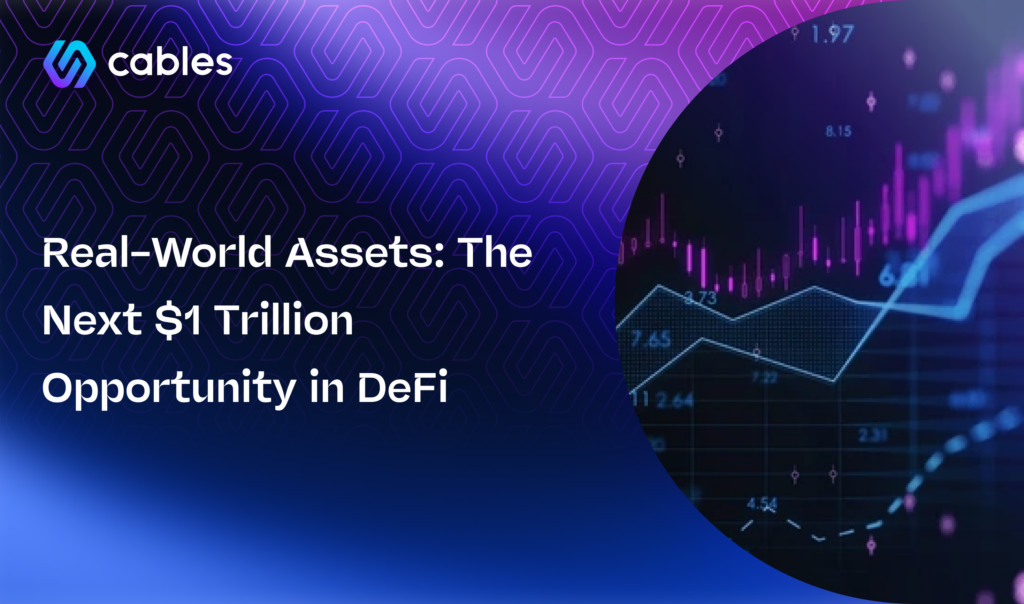Share this article:
Real-World Assets: The Next $1 Trillion Opportunity in DeFi
The decentralized finance (DeFi) sector has long been centered around crypto-native assets, but a new frontier is emerging—one with the potential to unlock trillions in value. The tokenization of real-world assets (RWAs) is bridging traditional finance (TradFi) and DeFi, creating a global ecosystem that enhances liquidity, accessibility, and financial inclusion. With industry leaders estimating the tokenized asset market to reach between $2 trillion and $16 trillion by 2030, this shift represents one of the most significant growth opportunities in DeFi to date.
The Trillion-Dollar Potential of RWAs in DeFi
Real-world asset tokenization converts traditionally illiquid assets—such as real estate, commodities, government bonds, and equities—into digital tokens on blockchain networks. This transformation allows for fractional ownership, 24/7 trading, and global accessibility, driving an unprecedented expansion of capital markets.
According to a 2023 report by Boston Consulting Group, the tokenization of financial and real estate assets alone could represent a $16 trillion market by 2030. JP Morgan, BlackRock, and Goldman Sachs have all actively pursued RWA tokenization initiatives, reinforcing the idea that this is not just a speculative trend but a fundamental shift in financial infrastructure. As institutional capital seeks efficient and transparent on-chain solutions, DeFi protocols that successfully integrate RWAs stand to capture a massive share of the global financial market.
Why RWAs Matter: The Liquidity and Accessibility Revolution
One of the primary advantages of RWA tokenization is its ability to unlock liquidity in traditionally static markets. Real estate, for example, has historically required significant capital and lengthy processes for buying and selling. By tokenizing property assets, investors can trade fractions of real estate on decentralized exchanges (DEXs) without intermediaries, reducing costs and improving market efficiency.
This increased liquidity extends beyond real estate. Government bonds and corporate debt—sectors that account for over $120 trillion globally—are being tokenized to facilitate easier secondary market trading. Additionally, tokenized commodities like gold, silver, and oil offer DeFi users access to historically stable assets, creating new avenues for hedging risk within decentralized markets.
Beyond liquidity, RWAs make financial markets more accessible. Investors from regions with underdeveloped capital markets can now participate in asset classes previously out of reach. By digitizing RWAs on blockchain networks, DeFi eliminates geographical and economic barriers, creating a more inclusive financial system.
Challenges in RWA Tokenization and Adoption
Despite its massive potential, integrating RWAs into DeFi comes with challenges that must be addressed for mainstream adoption.
- Regulatory Uncertainty – Regulatory bodies worldwide are still determining how to classify and oversee tokenized assets. Compliance frameworks are evolving, and DeFi protocols must navigate jurisdictional complexities to ensure long-term viability.
- Institutional Adoption – While major financial institutions are exploring blockchain-based RWAs, broader adoption depends on bridging trust between DeFi protocols and TradFi players. The need for secure custodial solutions, regulatory clarity, and interoperability with existing financial infrastructure remains crucial.
- Technological Integration – Ensuring smooth interoperability between on-chain and off-chain financial systems requires innovative solutions. Secure oracles, decentralized identity verification, and automated compliance mechanisms are key to scaling RWA adoption within DeFi.
How Cables Finance is Building the RWA Ecosystem
Cables Finance is creating an integrated DeFi ecosystem designed to maximize the potential of RWAs. By combining liquid staking tokens (LSTs) with perpetual futures for FX real-world assets (RWAs), Cables provides a capital-efficient infrastructure that enhances both yield generation and trading opportunities.
At the core of the Cables ecosystem is the Cables LST Platform and Perps DEX, which enables users to deposit any asset, earn yield on it, and use it for trading or leverage—all within a unified framework. This model seamlessly incorporates yield-bearing RWAs such as tokenized government bonds, FX reserves (cEUR, cJPY, cXAU), and commodities, allowing users to access liquid, globally tradable assets in DeFi.
By addressing liquidity, accessibility, and interoperability challenges, Cables Finance is not just participating in the RWA movement—it is actively shaping the infrastructure for the next wave of financial innovation in DeFi. As the market grows, Cables is at the forefront, creating the foundation for a decentralized, multi-asset financial system that bridges traditional finance with the limitless potential of blockchain. Be sure to follow us on X (Twitter)!
Share this article:


